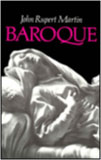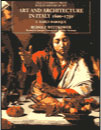|
Recommended Readings
|

Baroque
by John Rupert Martin
In this classic study Professor Martin introduces us to the essential qualities of Baroque art, telling how Mannerism was finally supplanted by Caravaggio's powerful naturalism and relating the new acceptance of sensual experience to a new curiosity about human psychology and the inner life. Throughout, he emphasizes this century's balance between the secular and the religious, an equilibrium which allowed spiritual or mystical qualities to permeate even the most apparently mundane of genre paintings, which is the great distinguishing feature of Baroque art.
More info
Buy now
|

Art and Architecture in Italy, 1600-1750
by Rudolf Wittkower, Jennifer Montagu; Revised by John A. Pinto
This classic survey of Italian Baroque art and architecture focuses on the arts in every center between Venice and Sicily in the early, high, and late Baroque periods. The heart of the study, however, lies in the architecture and sculpture of the exhilarating years of Roman High Baroque, when Bernini, Borromini, and Cortona were all at work under a series of enlightened popes. Wittkower's text is now accompanied by a critical introduction and substantial new bibliography. This edition-now published in three volumes-will also include color illustrations for the first time.
More info
Buy now
|
|
      
|
Technique
Why are there no drawings by Caravaggio but many by Annibale Carracci?
What does this indicate about their working methods and conception of the nature of art?
The two 17th century masters, Caravaggio and Annibale Carracci had different approaches for executing a painting. Without further study Caravaggio could easily copy nature, imitating common forms without beauty, he was known as the painter of common people with dirty-feet and ragged sleeves...
...more 
|
|
Pietro da Cortona and Alexander VII
Discuss the role Pietro da Cortona played in the urban and architectural projects of Alexander VII.
Pope Alexander VII ruled for twelve years, between 1655 and 1667, and in that time he changed the face of Rome more profoundly than any of his immediate predecessors. Among other advisors, Bernini and Cortona were in a class by themselves in Alexander's esteem. Together, they realized Alexander VII's vision of his Rome: a multiple stage set that could transform spaces and monuments into theatres, or teatro, of stylized action.
...more 
|
© Copyright 1999, 2000, 2001, 2002
|










